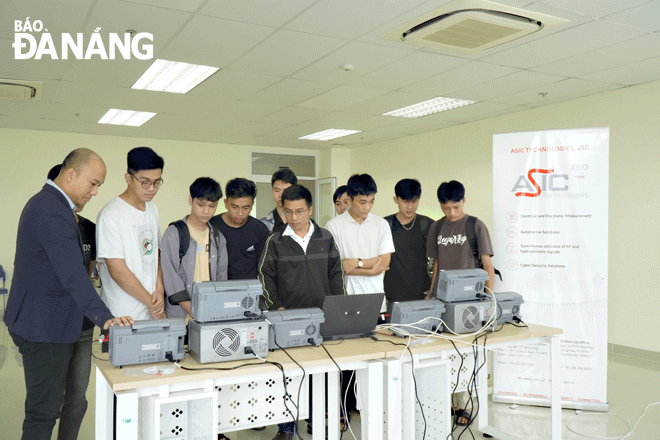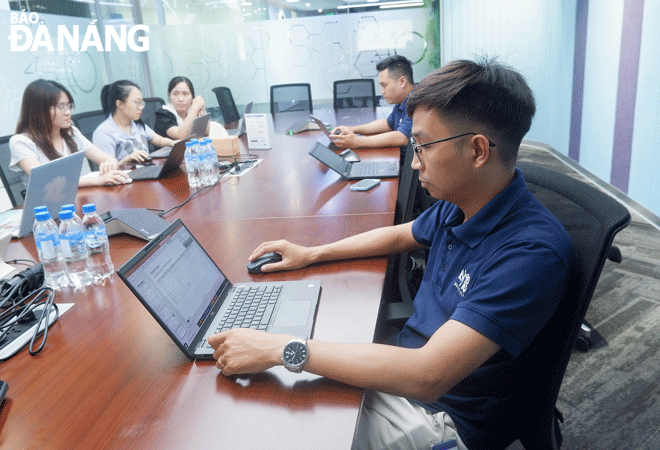Da Nang boasts many advantages in microchip industry
Decision No. 1287/QD-TTg dated November 2, 2023 of the Prime Minister approving the Da Nang Master Plan for the 2021 - 2030 period, with a vision towards 2050, determining Da Nang to become one of the industrial centres for hi-tech and supporting industries in Viet Nam, including microelectronics, semiconductor chip technology and semiconductor microcircuits. What does Da Nang need to do to take advantage of the golden opportunity from the semiconductor industry, which is forecast to be a trillion-dollar economic industry?
 |
| Students of the Da Nang University of Science and Technology are supported by businesses with electronic equipment for laboratories serving majors related to microchips, early November, 2023. Photo: M.Q |
At a recent workshop “Developing human resources to serve the semiconductor chip industry - Issues facing Da Nang”, the city identified priorities for developing policies related to investment attraction, international cooperation and initial support to spread research and training of semiconductor IC human resources in the coming time.
Many local advantages
The Da Nang administration is directing relevant agencies to urgently develop a project to develop semiconductor chips and microchips in the city, at the same time conducting research to develop mechanisms and policies to develop human resource, especially attracting talent in thus lucrative segment. This is one of the important tasks to realize the aspiration of building Da Nang to soon become a destination for semiconductor circuit design.
Previously, since the 2000s, the city has issued guidelines and policies as a foundation for developing the information technology (IT) industry, for example Resolution No. 07-NQ/TU dated October 3 -2000 on a number of policies to develop the software industry and Resolution No. 06-NQ/TU dated March 12, 2003 on promoting the application and development of IT.
The Resolution of the 22nd Da Nang Party Congress for the 2020 - 2025 term identified one of three key, breakthrough tasks as ‘Strongly innovating the growth model, restructuring the economy, focusing on strongly developing hi-tech industry and IT, associated with building creative startup urban areas and smart cities, creating a foundation to promote the development of new industries and fields, especially the digital economy., digital society and digital government”.
Along with that, the Da Nang People's Committee issued Plan No. 163/KH-UBND dated August 16, 2023 on developing the IT industry in the city until 2030, which identifies priorities for microcircuit design and production.
Recently, from November 14 to 17, during a business trip to the United States, under the witness of State President Vo Van Thuong, Da Nang signed a memorandum of cooperation with leading semiconductor chip corporations and businesses in the US, and world as a whole.
Specifically, in San Francisco, the Da Nang People's Committee and Synopsys Company inked a memorandum of cooperation related to the development of the semiconductor field in Da Nang in the near future.
According to Mr. Trinh Thanh Lam, Sales Director of Synopsys South Asia, during the process of researching Da Nang's development strategy, he realized that if Da Nang chose to develop conventional industries and technologies, it would no longer have a land fund. If the city wants to make more future development strides, it must choose hi-tech industries, including the semiconductor industry.
The Synopsys leader also said that Viet Nam is one of the company's strategic investment destinations in Asia-Pacific. During the 2020 - 2022 period, Synopsys Vietnam developed 4 offices in 2 big cities namely the southern metropolis of Ho Chi Minh City and the central city of Da Nang, attracting nearly 500 engineers in total.
Also within the framework of this working visit to the United States, at the investment promotion conference ‘Da Nang - Destination for semiconductor investment’ in San Jose (California, the United States), Da Nang and the Company ITSJ-G signed a memorandum of cooperation in the field of design and production of electrical and electronic components.
The Qorvo company in the United States has proposed that Da Nang consider supporting training programmes for circuit design, electrical and electronic engineers and promoting the development of hi-quality human resources in the field of local semiconductors as well as increasing investment in chip and semiconductor field infrastructure.
Particularly, another US company, the Marvell, is very interested in the development of the semiconductor industry in Viet Nam in general and highly appreciates the potential for development of the semiconductor industry in Da Nang in particular.
As informed by the company, in January 2024, the company’s representatives will visit Da Nang to survey opening an office here. Notably, at the meeting with the Da Nang delegation, the Intel Corporation highly agreed on the city's proposal on soon implementing bilateral cooperation on human resource training in Da Nang, combined with the group's Artificial Intelligence for the Future ("AI for Future") programme and supporting Da Nang to build “The high performance computer centre” and deploy a laboratory to serve the assembly and testing of microchips and semiconductors in the city.
 |
| Employees at the Da Nang branch of the Synopsys Vietnam Co., Ltd. in Hai Chau District are at work. Photo: M.Q |
Difficulties need to be resolved
The potential for developing the semiconductor industry in Viet Nam, and Da Nang in particular, is very large with many opportunities to attract investment and receive technology transfer from international corporations of the United States and other partners. However, there are still certain difficulties.
According to Mr. Bui Le Anh Hieu, the Marketing - Sales Director of the Long Hau Joint Stock Company, currently the occupancy rate in industrial parks across the city is relatively high. The professions that have been attracted to industries are scattered in many fields and the number is not large. Therefore, a manufacturing business community with complementary properties has not been created and the supply capacity for new businesses coming to Da Nang to research and invest has still been limited.
In addition, the remaining industrial park land fund is not much, which also limits the ability to attract new projects. Road and air infrastructure are relatively developed, facilitating inter-regional traffic. However, seaport infrastructure is still limited because the volume of goods traffic and the number of trips through the current Tien Sa port are not high.
With regard to labour resources, Da Nang has many advantages in terms of labour resources in the service and IT sectors. According to Mr. Hieu, to develop hi-tech production and supporting industries, more solutions are needed to provide better supply for businesses, and besides, it is necessary to continue to create more industrial land funds and supporting services for production in an effort to attract more investors.
Besides difficulties in infrastructure and land, Da Nang needs to do well in training high-quality human resources. The city currently has about 250 businesses operating in the field of manufacturing, processing, and assembling electronic components with a total of nearly 10,500 employees. Particularly, the semiconductor industry’s human resources in Da Nang ranked third in the country, after Ho Chi Minh City and Ha Noi, and Da Nang only accounted for 7%.
In his perspectives, Associate Prof. Ph.D. Ha Dac Binh, the Principal of the School of Technology, the Duy Tan University, said that semiconductor circuits are a "picky" field of study for students because it requires learners to have a background in STEM related to the fields of science, technology, engineering and mathematics as well as foreign language proficiency because most are involved in foreign projects.
As for Assoc. Prof., Ph.D Huynh Cong Phap, the Rector of Viet Nam - Korea University of Information and Communications Technology, a member school of the University of Da Nang, assessed that most training institutions have difficulty in attracting lecturers with highly practical experience in this semiconductor circuits and facilities as well. Besides, the investment and operating costs of a practice-experiment system for this field are very large.
Similarly, according to Assoc. Prof., Ph.D Nguyen Hong Hai, the Vice Rector of the University of Science and Technology, a member school of the University of Da Nang, compared to the total number of annual graduates (in related majors), the number of students in the field of microchips and semiconductors is quite modest, accounting for only about 10%. These are issues that the city is concerned about and need solutions in the near future.
Reporting by THANH LAN - Translating by A.THU








